Updated: 20-Mar-2020
The "Société des Moteurs Gnome" was founded by the Seguin brothers.

"Factory entrance in 1909"
-Louis, who was the eldest, as director and engineer, and Laurent as an engineer. The third brother Augustine is not known for having activities related to the above mentioned.
-They were engineers of the Arts and Manufactures of Paris (Arts et Métiers) around 1895, and in 1900 they built industrial engines and motors for light crafts.
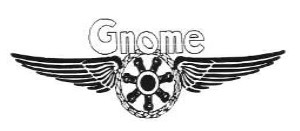
“Gnome logo”
-The first engine with the intention of being used in aviation was experimental, the Seguin brothers themselves acknowledged that the results obtained, exceeded the most optimistic forecasts.
-It was a 7-cylinder engine that gave 34 CV at 1,300 rpm with 100 mm of stroke by 100 mm diameter, displacing about 3.4 liters in total.
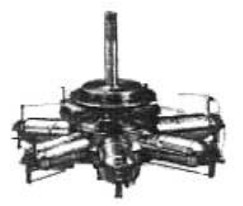
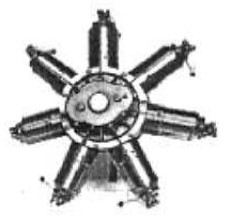
“Test prototype”
-The prototype did not have cooling fins on the cylinders because the purpose was to demonstrate the principle of operation.
-Below we show some Gnome engines at the Museum of Les Arts et Metiers in Paris.


"Two views of the first Gnome, without fins"
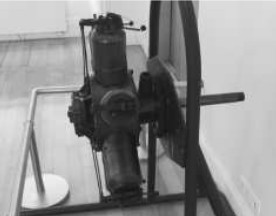
"Another side view of the gnome without fins"
-It is considered that the Gnome prototype would lead to the great rotary radial engine constructor. In 1908 they made a 7-cylinder prototype with fins on the cylinders, and controlled valves. It gave 50 CV at 1,200 rpm, displacing 8 liters. There was a single common valve for intake and exhaust.
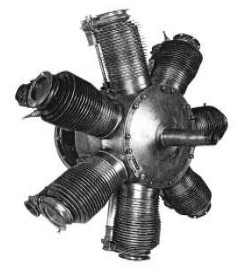
“1908 prototype”
-The concept of the rotary engine is original because the propeller is fixed to the central engine block assembly, which, together with cylinders, pistons and connecting rods, is rotating while the crankshaft is fixed to the structure of the aircraft.
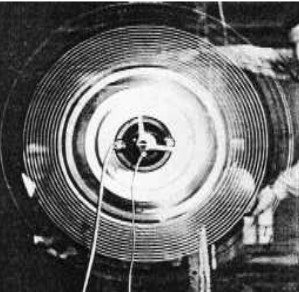
"Running Gnome engine”
-When rotating at such a speed, part of the external cylinder cooling is entrusted to their own movement. Inside, centrifugal forces make the mixture flow towards the periphery, and opening and closing valves in some models is also relied on counterweights.
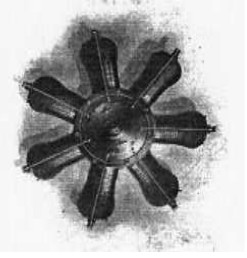
“Omega”
-The second engine -and the first useful one- was the "Omega", of 1909. It was a seven-cylinder radial that gave 50 CV at 1,200 rpm with 8 liters of total displacement. The same data as the valve prototype.
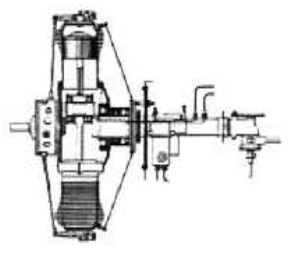
“Omega schematic diagram”
-The "Omega" was the final prototype, with fins and was exhibited at the Paris Air Show at the Grand Palais in 1908 and 1909.
-The seven-cylinder engine was a regular radial, with a circular crankcase.
-The assembly rotates on the crankcase axe, which in this case is the crankshaft, with a single elbow and fixed to the airplane as mentioned before.
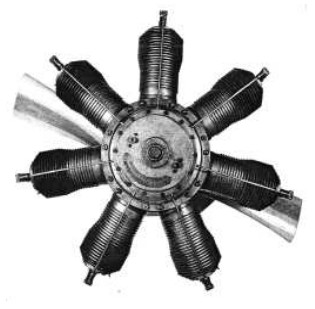
“Omega at the Safran museum”
-There is no privileged cylinder, all of them work in the same conditions. There is a massive use of nickel steel.
-The cylinders are forged and fully machined, extremely light, with an internal diameter of 110 mm and a stroke of 120 mm.

“Gnome 1910 prototype”
-A graphic information shows us a 7-cylinder Gnome with spherical-shape counterweights that are used by some models in the valve rocker arms, and that are acting by centrifugal force.
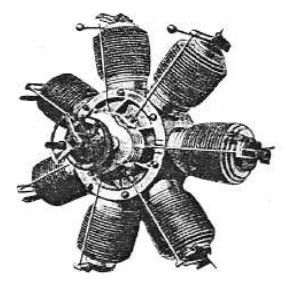
“Gnome 7-cylinder, 50 CV”
-Below we show one of the most complete schematic diagrams of a Gnome engine installation.

“Schematic diagram of a 7-cylinder Gnome engine”
-The carburetor is at the end of the rear shaft (prolongation of the crankshaft). Half way, the grease oil is injected.
-We are informed that the gasoline consumption was 300 gr/CV/Hr (50 grams more than optimal) and that there had to be added about 60/70 grams of castor oil, mixed with the gasoline.
-Just ahead of the front support that fastens the engine to the fuselage arrives the current from the magneto to the track sector and the cable that feeds the spark plug for igniting the corresponding cylinder.

“The 50 CV exhibited in Paris”
-The position of the propeller behind the engine occurred in several engines, observing photographs carefully.
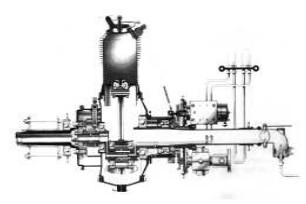
“Drawing for the Gnome 50 CV, cross-section”
-The Gnome engine drawing highlights the lubrication and feeding system, like the the 7-cylinder schematic diagram shown above.
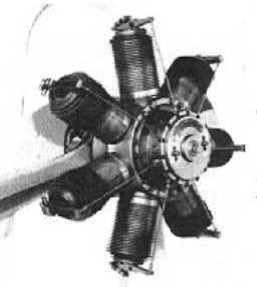
"Another example of a rear propeller"
-There were rotary engines with fixed gearboxes. Here we provide another example of an engine that is already mounted on an airplane structure. It is interesting to see that the blades are fitted on the propeller hub. We can clearly see the gearbox.
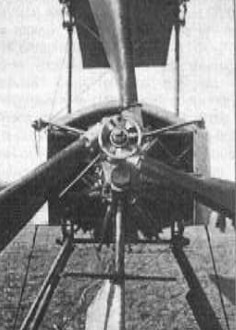
“On a Breguet, in 1910”
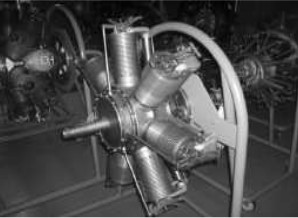
"7-cylinder Gnome prototype"
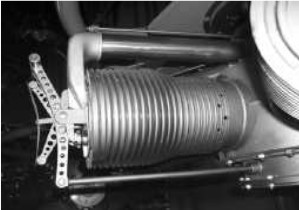
"Detail of the previous engine"
-Between 1908 and 1910, another prototype with controlled valves like in the picture below, was tried out.
-The counterweights of the rockers are to counteract the centrifugal forces.
-Testing prototype engines, in 1910-1911 appears an experiment of a barrel type, of which we have already seen several engines in this A-Z publication.
-It was part of a plan of investigation and tests. As we will see, this path was not insisted on.
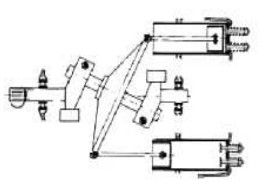
“Barrel engine principle”
-In the schematic diagram of the operation principle we see a tilted plate with the connecting rods driving its periphery, causing its rotation.
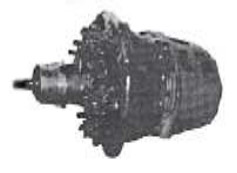
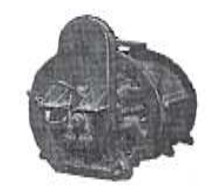
“Gnome barrel type engine”
-This engine was known as the Gnome "Barrilet" type, and gave about 50 CV. It did not come into production.
-It was water cooled with 9 cylinders parallel around the axis. (Revolver type).
-It was an accomplishment of Laurent Seguin towards 1910. It had a reduction of 2 to 1.
-It is said that the first attempts to build aviation engines by the Seguin brothers was with fixed-radial engines that had superimposed gear reduction (formula later adopted by Pobjoy). This engine is from 1907.

“5-cylinder fixed radial”
-It had 5 cylinders and gave 35 CV. The photo was made in Chalais-Meudon (the French INTA).
-Today it is in the warehouse of the Le Bourfet Museum.
-Later on we will see another engine with reduction gear, but rotary, very interesting.
-In the MAE's reserve warehouse there is a Gnome prototype with a rare intake tube -not usual for the brand- and a delicate valve control system.
-It also has exhaust ports at the base of the cylinders.
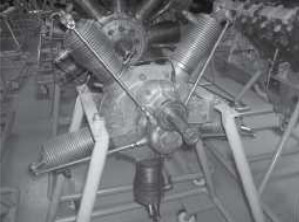
“Gnome fixed radial with gearbox”
-The Omega was one of the most built and easy to find engines at the various museums.

“Omega at Les Arts et Metiers Museum”
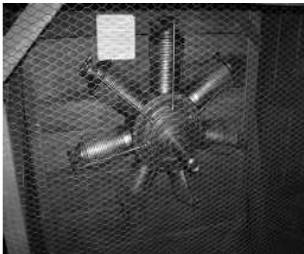
“Omega in simulation at the Voisin workshop, MAE”
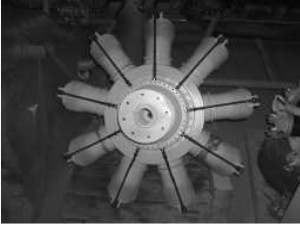
“Repainted 9-cylinder Gnome at the MAE”
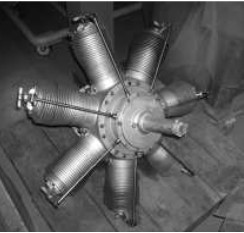
"Gnome recently arrived at the MAE, (2008)"
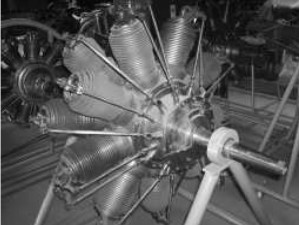
“Gnome BB”

“14-cylinder Omega”
-Through the coupling of two "Omega" 7-cylinder engines, the 100 CV appears in 1909, and after that the power increases little by little, 120, 140 CV, as a result of improving the engine. It was called "Double-Omega" and "Omega-Omega".
-The 14-cylinder, 100 CV engine that weighed 130 kg, was presented in 1909, at the Aviation Week in Reims on a Bleriot monoplane.

“Bleriot in Reims”
-Contradictory publications present the Gnome "Double-Delta" (or Delta-Delta) as "Double-Omega". Although the type of rockers that we see in the photograph correspond rather to an "Omega", by the number of cylinders, 9 +9, it turns out to be a "Double-Delta".
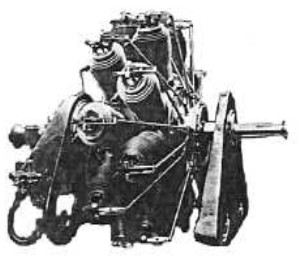
“Double-Delta”
-The simple "Delta" was a 9-cylinder engine that we see below. It delivered 70 or 80 CV.
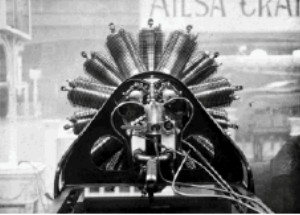
“Gnome Delta”
-The "Gamma" from 1910, was a 7-cylinder and gave 70 CV at 1,200 rpm with 11 liters of displacement.
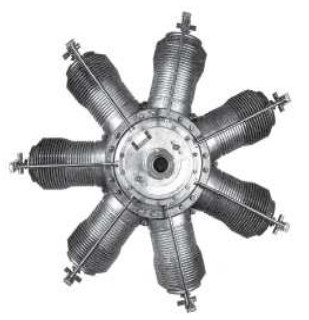
“Gamma at the Safran museum”
-The classic system of Gnome was an exhaust valve controlled by rockers -and counterweights- with control rods.
-However, the admission was made by an automatic valve mounted on the piston head through which the mixture passed from below into the cylinder.

"Piston with valve in head"
-It was a game of balance between the pressures on both sides and the centrifugal forces.
-They were a real pain for mechanics.
-After the Lambda, there were no more piston head valves.

"Pre-Monosoupape Classic Cylinder"
-The most famous Gnome engines are the "Monosoupapes" or "Monovalves" that appeared in 1912 and from which the best known models were made until 1916.
-The 60 CV, 7-cylinder was air cooled as all rotary engines. It had no inlet valve on the piston and with ports at the end of the cylinder stroke where the mixture enters, aided by centrifugal force.
-It used the 4-stroke cycle.

“Gnome Monosoupape A”
-The A model gives 80 CV and is from 1913.
-The Monosoupape designs were the result of following a path that could be expanded more than the Omegas.
-Only the exhaust valve in the cylinder heads is maintained.
-One of the faults that occurred in Omega engines with piston valves is that if they failed, which was often the case, there were false explosions in the crankcase and the hollow crankshaft to the carburetor.
-Another characteristic of the Gnome engines was that by having a continuous flow of fuel they worked thoroughly or not at all.
-The pilot cut or connected sparking through an ignition switch. That is why the characteristic bursts occured upon landing.
-The type B Monosoupapes (from 1914) gave 100 CV, and followed the same principles of not having piston valves.
-The centrifugal force of the rotation itself blew the air/fuel/oil mixture towards the periphery, and in this case through the ports as well.

“Monosoupape B”
-The Gnome B engines were generally known as 9B because of the nine cylinders. But within the series there were variants for improvements.
-The B-2 version, like the previous one, also delivered 100 CV.
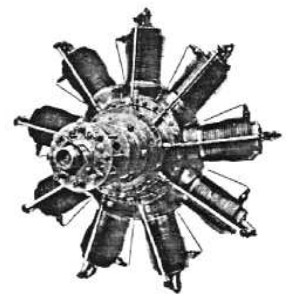
“Model 9B, 100 CV”
-The 9B is sometimes mentioned as B9. In these engines (including the B-2, etc) the entering process of the mixture into the cylinder, in addition to the centrifugal force, was favored by a certain depression created inside the cylinder as the piston descended and the exhaust valve was opened at the cylinder head, so the filling was quite effective. In addition, the exhaust valve had better cooling.
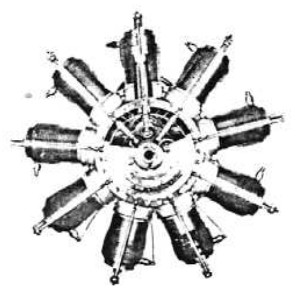
“B-2 Variant of the 9B”
-Another ingenious way to vary and regulate the speed of the entire engine was controlling the opening time of the valve. The other regulation, as has been said, is ignition control.
-There was no throttle valve in the carburetor to control the speed.
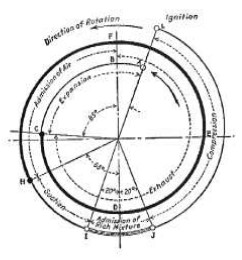
“Monosoupape distribution”
-These engines were very temperamental and the pilots' expertise and knowledge could be favorable or detrimental in combat.
-Do not forget the strong gyroscopic effect of the egnine mass rotating in one direction.
-Especially in the "dogfight", the plane turned instantly to the left, but to the right it was very slow.
-According to the pilot, this could be something useful, if he took advantage of this characteristic.
-With the change of tactics at the end of the war with fast passes instead of getting involved, the advantage was for liquid-cooled engines, leaving the rotaries being an anachronism.
-The 9C with 9 cylinders gave 125 CV.
-The next practical engine was the 9N that gave 160 CV at 1,250 rpm. It entered into service in 1914, and was part of the Monosoupape series. It had simple ignition.
-The total displacement was 15.9 liters. Its nine cylinders had a diameter of 115 mm and a stroke of 170 mm.

“9N cross-section”
-The 9N was used primarily on the French Nieuport 28 in WWI. The US Air Service acquired almost three hundred devices at that time.

“The 9N exhibited at the Safran Museum”
-Curiously a derivative of the 9N was the 9M, which would remain as a prototype.
-It had more displacement and more power, reaching 200 CV with 19.8 liters of displacement.
-The 9M had double ignition. And as a special feature it had a cylinder-lubrication system: having a pump, it was possible to get the oil to the cylinder walls as we can see in the below figure.
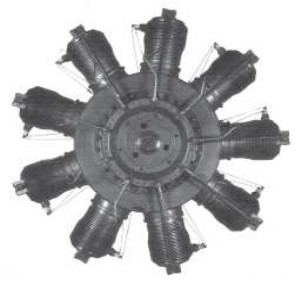
“Monosoupape 9M in Villaroche” (PiP)
-The Monosoupapes were made with 7, 9, 11, 14 and 18 cylinders, and had powers of 80 to 240 CV. The 11-cylinder, from 1915, gave 200 CV at 1,200 rpm. It displaced 19.450 liters for 172 Kgs. of mass, that is a weight/power ratio of 0'8.
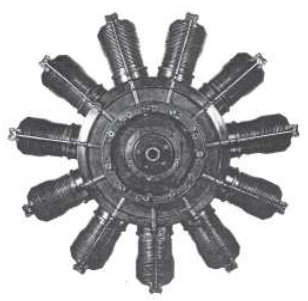
“11-cylinder prototype” (PiP)
The 11-cylinder did not come any further than the prototype stage, and there is no information on any application available.
The Gnome 18C, from 1916, was a double application of two 9-cylinder Monosoupapes. It gave 240 CV at 1,300 rpm and had 28.3 liters of total displacement. The cylinders were 110 x 165 mm, somewhat smaller than the 9N.
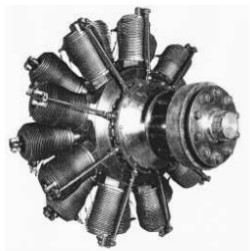
“18C at the MAE in Paris”
-As a curiosity, the price of this engine in its day was 30,000 FF. One of its mountings was on the Morane. There was another experimental 18-cylinder that gave 300 CV in 1916-17.

“Gnome 18C”
-Another experimental engine was the 14-cylinder with fixed gearbox and rotary engine. See the different anchors to the aircraft structure.
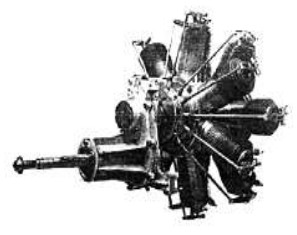
“14-cylinder rotary with gearbox”
-Going back in time, the last piston-valve Gnome engine was the "Lambda" of 1912.
-As all the brand's initial engines, it used a Greek letter as the identification name. The engine was derived directly from the Omega.
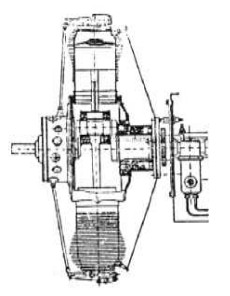
“Gnome Lambda cross-section”
-A simple7-cylinder radial that gave 80 CV at 1,200 rpm. It had the exhaust valve on the cylinder head and the intake valve on the piston. It had simple ignition. In this case the spark plug is not visible in the photograph because it is directly behind the cylinder. It had a displacement of 12.3 liters.
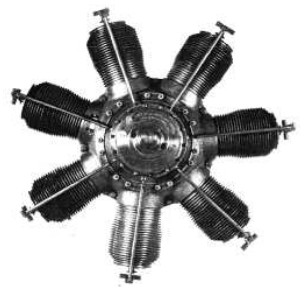
“Lambda”
-To extract more power from this engine, the "Double-Lambda" or "Lambda-Lambda" was made. This engine was the result of the assembly of two 80 CV Lambdas to give 160 CV.
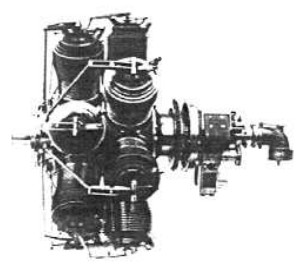
“Double-Lambda”
-At the rear, now we do see the magneto with its permanent magnet, and let's say a "simple carburetor" and a filter.
-With a Double-Lambda of 160 CV, the World Record was obtained in the 1913 Gordon Bennett Cup, with Deperdussin airplane.
-The "Sigma" engines, from 1910, gave 60 CV, and were mounted on Morane, Farman, Deperdussin and Vraciu II aircraft. The Double-Sigma gave 120 CV.
-Gnome engines were built in many countries, even a factory was installed in Russia where the Omega, Lambda and Monosoupape were made. After the 1917 Revolution the factory was hijacked by the new administration to equip the airplanes that were also made under license at that time.
-The manufacturing licenses were also given to the USA, the UK, Sweden and Germany (Oberursel).
-In 1915, the Gnome Company acquired Le-Rhone, working both together as Gnome-Rhone until the mid-1940's.
-Summing up, apart from the prototypes and experimental ones, the main Gnome engines can be:
- “Omega”, 7-cylinder, 50 CV -1908.
- “Sigma”, 7-cylinder, 60 CV - 1910.
- “Gamma”, 7-cylinder, 70 CV - 1910.
- “Lambda”, 7-cylinder, 80 CV - 1912.
- “Delta”, 9-cylinder, 100 CV - 1912.
- “Omega-Omega”, 14-cylinder, 120 CV -1910.
- “Gamma-Gamma”, 14-cylinder, 130/140 CV.
- “Sigma-Sigma”, 14-cylinder, 120 CV.
- “Lambda-Lambda”, 14-cylinder, 160 CV - 1913.
- “Delta-Delta”, 18-cylinder, 200 CV.
- “Type A”, 7-cylinder Monosoupape, 80 CV - 1913.
- “Type B”, 9-cylinder Monosoupape, 100 CV - 1914.
- “Type C”, 9-cylinder Monosoupape, 125 CV.
- “Type M”, 9-cylinder Monosoupape, 200 CV.
- “Type N”, 9-cylinder Monosoupape, 160 CV.
- “Double N”, 18-cylinder Monosoupape, 300 CV.
- “18C”, Monosoupape, 240 CV.
- “11-cylinder” Monosoupape, 190 CV.
- Motores “Barrilet”.
-The first 7C rotary units had a feature that made them unique, and it refers perhaps to the first five engines of the series.
-It is the case that between each two cylinders there was only one through bolt that joined the two halves of the central crankcase. Later, in the rest of the units, two bolts appear.
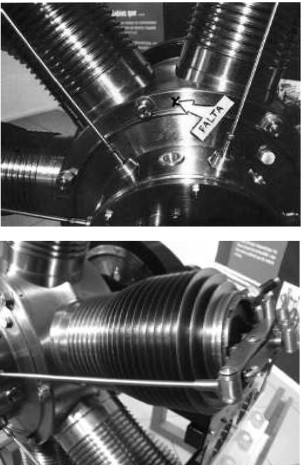
"Detail of the single bolt between cylinders"
-This is the 7-cylinder Omega of the C series. This engine belongs to the private collection of Josep Castellseguer in Mataró (Barcelona).
-The restoration was done by him and his team. He told me that he found it under a mechanic's workbench in France, full of rust and dust. It was an exciting discovery.
The restoration is exemplary.
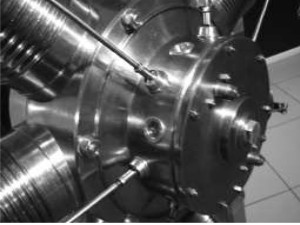
"Another view of the Gnome with the lack of the 2nd bolt"
-In the main text we see that most of the Gnome engines have double through bolts in that same situation, except one engine that has 7 cylinders,and counterweights on the rockers.

“Rear view”
-At the rear there is the fixed shaft, the two supports that join it to the fuselage and a couple of accessories: the lubrication pump and the magneto on the right.
-At the 1910 Paris Air Show, the Gnome 14-cylinder rotary radial, giving 100 CV, was presented.
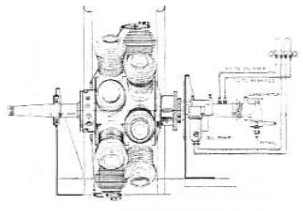
“Schematic diagram of the engine”
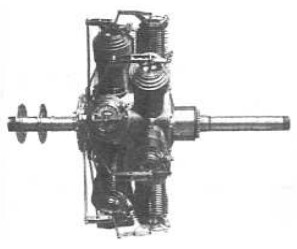
“Side view of the engine”
-In the photo above we see that the shaft, which has to be fastened to the structure, is bare of accessories. (Right side).
-The prolongation of the front propeller shaft is also unusual. But the explanation is found in the illustration below, in which we see that the engine is supported at the front and rear with some important fittings.

“14-cylinder Gnome engine on its bench”

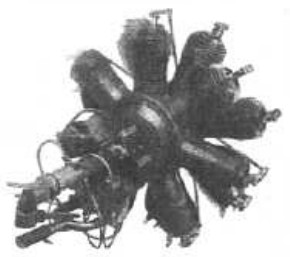
“Angled front and rear views”
-Below we show a repertoire of illustrations from the time of these interesting engines.

“Monosoupape B2 at the NASM”

"14-cylinder Gnome engine”
-We have pictures of test benches with Gnome engines.

“With the propeller behind the engine on a bench”
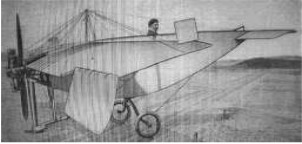
“The same assembly on a Bleriot design”
-The field test benches used to be portable, some on a metal structure or something similar, conveniently adapted, as we see, with oil and fuel tanks, a calculated aerodynamic brake in place of the propeller.
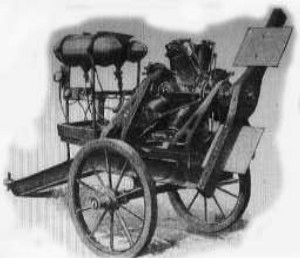
“Field test bench with 14-cylinder Gnome engine”
-We got a picture of two Gnome engines installed in tandem. See main text to see something similar, at the Safran Museum.

“Double installation for aircraft”
-Below we show a curious triple assembly in tandem of three Gnome 50 CV engines on the English Radley Seaplane.
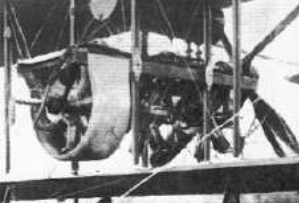
“Triple Gnome engine assembly”
-We located some unique versions of Gnome engines. Starting with a triple assembly that reaches 150 CV. They are three coupled 7-cylinder engines, each giving 50 CV.
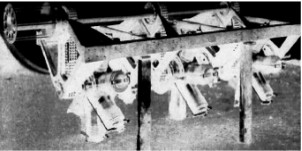
“Tripple Gnome” (PiP-fmr)
Author's note: It is clear that major powers were sought by grouping several of the small engines available during WWI. It is not surprising that when the Hispano Suiza 150 hp V8-engine appeared, in addition to being much more reliable, it disapeared.
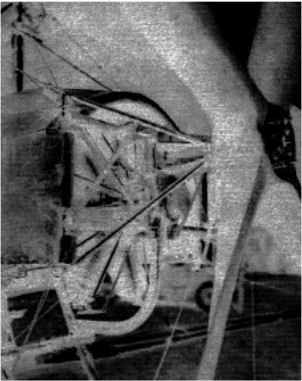
“Gnome rotary with gearbox” (PiP-fmr)
-However, Gnome insisted on looking for better results with rotary engines, coupling fixed gearboxes as in the cases shown.
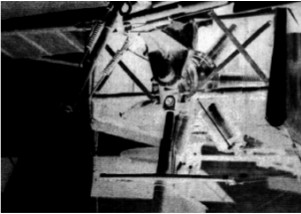
"Another example of a Gnome with gearbox" (PiP-fmr)
-Around 1913 a Gnome installation was tested on a Demoiselle by Santos Dumont. Being twice as powerful as the original engine of this device, it had capacity for two passengers.

“Gnome on Demoiselle, 2 pax” (PiP-fmr)
-In a Czech publication we located a Gnome version that is not exposed in the main text. It differs mainly in the front gears inside a box that can make it bi-rotational.

“Gnomewith strange front gearbox” (PiP)

“Cross-section for the above engine” (PiP)
-We see that the connection system of the connecting rod heads to the crankshaft heads is classic, however, the piston valve and the upper exhaust one are those of the first generation.
From Appendix 9: In the year 1910, two rotatary radial models are shown in a German book (by A. Vorreiter).
-Remember that the first Gnome engines were the Omega 50 CVs.
-In 1910, the Sigma appeared with a power of 60 CV, the Gamma with 70 CV and the Double Omega with 100 CV.
-As the book's edition is from 1910, it is to be assumed that this first engine that appears is the 50 CV Omega.
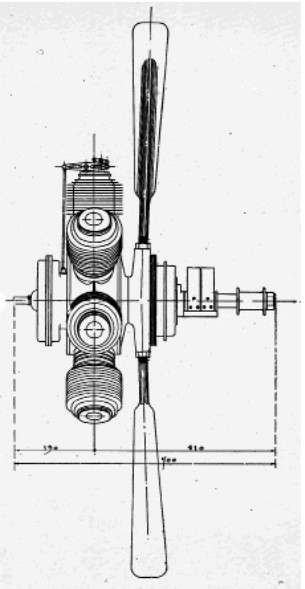
“The 50 CV Gnome with propeller behind the engine”
-By the layout, this power plant should work as a pusher instead of a puller. At that time, such a system was common.
-Perhaps one of the following aircraft of that time was powered by this engine: the Farman, the Breguet, the Paulhan, the Fabre, the Sommer and the Bleriot.
-Another engine that is from the year of the book's publication is the rotary engine with a design that is different from the previous one, and that also appears in the main text.
-First, the fins are larger in diameter, the valve control mechanism is also of different design.
-What catches the eye, is the valves' counterweight system. In general these rotary engines have very weak valve springs since they entrust the closure to the centrifugal force.
-Actually, it is a game of balance and strength. In this type of engines we see counterweights in the most different forms. We also see some sheets for the connections of the spark plug ignition wires.

“Engine view with control device”
-This is an interesting Gnome that does not fit in the known group of engines with names of Greek letters. The anchorage is not clear either and if it is the front or rear side. See the beginning of this chapter.
From Appendix 10: Known for its rotating radial motors, Gnome also made other experimental engines such as the Barrilet Type (see main text).
-From my friend Guy Leclercq of AAMS I have received a cutting of a Le fana magazine, in which appears a photo of a rare Gnome engine with horizontally opposed cylinders.
-It is described as model "F" and in the photo it seems taken from above or below with cover or crankcase removed.
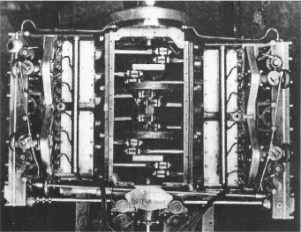
“Gnome F” (LeFana)

“Better photograph of the Barrilet engine" (LeFana)
-Two new views of a Gnome Delta-Delta, 200 CV.

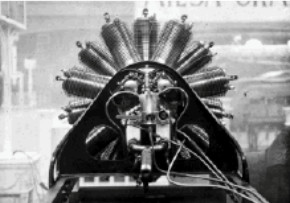
“Gnome double Delta, (Delta-Delta)”
-There was an advertisement in the USA of the rotary Gnome engine, the "Aviation Witch" that was still in the company of the "Seguin" brothers.
-After that only "Gnome". The price is very high compared to other engines of the time.
From Appendix 12: We show an engine that appears in the MARS, of material spreading 1914-1918.
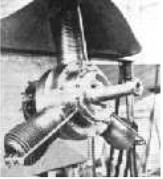
“Gnome rotary engine from 1911, 25 CV”
-They inform that it is a little-known model and that it is the base for the "Omega".
-In the field it was common to use a cannon structure to build an engine test bench during WWI. Or, factory equipment with the generic support of an airplane.
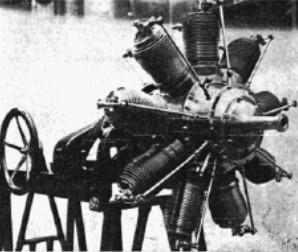
“Breaking-in bench for a Gnome rotary”
Engines of GNOME
Model: 11 cyl. rotativo Monosoupape
Arquitecture: 4-stroke11-cylinder Rotary
Cooling: Air
Total Displacement: 19450 cc
Bore / Stroke:
Power: 200 CV @ 1200 rpm
Weight: 172 Kg
Prototype only
Model: 18C rotativo Monosoupape
Arquitecture: 4-stroke18-cylinder Rotary
Cooling: Air
Total Displacement: 28300 cc
Bore / Stroke: 110 x 165 mm
Power: 240 CV @ 1300 rpm
Weight:

"Gnome 18C at the MAE in Paris"
Model: 34 CV, rotary prototype
Arquitecture: 7-cylinder Rotary
Cooling: Air
Total Displacement: 3400 cc
Bore / Stroke: 100 x 100 mm
Power: 34 CV @ 1300 rpm
Weight:

"First Gnome, without fins, fig. 2"
Model: 5 cyl. radial (non rotary)
Arquitecture: 5-cylinder Radial
Cooling: Air
Total Displacement:
Bore / Stroke:
Power: 35 CV
Weight:
Model: 50 CV, rotary prototype with fins
Arquitecture: 7-cylinder Rotary
Cooling: Air
Total Displacement: 8 Ltr.
Bore / Stroke:
Power: 50 CV @ 1200 rpm
Weight:
Model: Barrilet, 50 HP
Arquitecture: 9-cylinder Barrel
Cooling:
Total Displacement:
Bore / Stroke:
Power: 50 CV
Weight:

"Gnome barrel-type engine"
Model: Delta, 9 cyl.
Arquitecture: 9-cylinder Rotary
Cooling: Air
Total Displacement:
Bore / Stroke:
Power: 80 CV
Weight:

"Gnome Delta"
Model: Delta-Delta, 18 cyl.
Arquitecture: 18-cylinder Rotary
Cooling: Air
Total Displacement:
Bore / Stroke:
Power: 200 CV
Weight:

"Gnome double Delta, front view"
Model: Double N, 18 cyl.
Arquitecture: 4-stroke Rotary
Cooling: Air
Total Displacement:
Bore / Stroke:
Power: 300 CV
Weight:
Model: Gamma, 7 cyl.
Arquitecture: 7-cylinder Rotary
Cooling: Air
Total Displacement: 11 Ltr.
Bore / Stroke:
Power: 70 CV @ 1200 rpm
Weight:

"Gnome Gamma at the Safran museum"
Model: Gamma-Gamma, 14 cyl.
Arquitecture: 14-cylinder Rotary
Cooling: Air
Total Displacement:
Bore / Stroke:
Power: 140 CV
Weight:
Model: Lambda, 7 cyl.
Arquitecture: 4-stroke7-cylinder Rotary
Cooling: Air
Total Displacement: 12300 cc
Bore / Stroke:
Power: 80 CV @ 1200 rpm
Weight:

"Gnome Lambda"
Model: Lambda-Lambda, 14 cyl.
Arquitecture: 4-stroke14-cylinder Rotary
Cooling: Air
Total Displacement:
Bore / Stroke:
Power: 160 CV
Weight:

"Gnome Double-Lambda"
Model: Monosoupape, type A, 7 cyl.
Arquitecture: 4-stroke7-cylinder Rotary
Cooling: Air
Total Displacement:
Bore / Stroke:
Power: 80 CV
Weight:

"Gnome Monosoupape A"
Model: Monosoupape, type B-2, 9 cyl.
Arquitecture: 4-stroke9-cylinder Rotary
Cooling: Air
Total Displacement:
Bore / Stroke:
Power: 100 CV
Weight:

"Gnome Monosoupape B"
Model: Monosoupape, type N, 9 cyl.
Arquitecture:
Cooling:
Total Displacement:
Bore / Stroke: x
Power:
Weight:
Model: Montaje doble (2 de 50 CV)
Arquitecture:
Cooling:
Total Displacement:
Bore / Stroke: x
Power:
Weight:
Model: Montaje triple (3 de 50 CV)
Arquitecture:
Cooling:
Total Displacement:
Bore / Stroke: x
Power:
Weight:
Model: Omega, 7 cyl.
Arquitecture: 7-cylinder Rotary
Cooling: Air
Total Displacement: 8 Ltr.
Bore / Stroke: 110 x 120 mm
Power:
Weight:

"Gnome Omega at Les Arts et Metiers"
Model: Omega-Omega, 14 cyl.
Arquitecture: 14-cylinder Rotary
Cooling: Air
Total Displacement:
Bore / Stroke:
Power: 100 CV
Weight: 130 Kg

"14-cylinder Gnome Omega"
Model: Rotativo 3 cyl. base Omega
Arquitecture: 3-cylinder Rotary
Cooling:
Total Displacement:
Bore / Stroke:
Power:
Weight:
Model: Sigma, 7 cyl.
Arquitecture: 7-cylinder Rotary
Cooling: Air
Total Displacement:
Bore / Stroke:
Power: 60 CV
Weight:
Model: Sigma-Sigma, 14 cyl.
Arquitecture: 14-cylinder Rotary
Cooling: Air
Total Displacement:
Bore / Stroke:
Power: 120 CV
Weight:
Model: Type A, 7 cyl.
Arquitecture:
Cooling:
Total Displacement:
Bore / Stroke: x
Power:
Weight:
Model: Type B, 9 cyl.
Arquitecture: 4-stroke9-cylinder Rotary
Cooling: Air
Total Displacement:
Bore / Stroke:
Power: 100 CV
Weight:

"Gnome Modelo 9B, 100 CV"
Model: Type BB, rotativo
Arquitecture:
Cooling:
Total Displacement:
Bore / Stroke: x
Power:
Weight:

"Gnome BB"
Model: Type C, 9 cyl.
Arquitecture: 4-stroke9-cylinder Rotary
Cooling: Air
Total Displacement:
Bore / Stroke:
Power: 125 CV
Weight:
Model: Type F
Arquitecture:
Cooling:
Total Displacement:
Bore / Stroke:
Power:
Weight:

"Gnome F"
Model: Type M, 9 cyl.
Arquitecture: 4-stroke9-cylinder Rotary
Cooling: Air
Total Displacement: 19800 cc
Bore / Stroke:
Power: 200 CV
Weight:
Prototype only

"Monosoupape 9M in Villaroche" (PeT)
Model: Type N, 9 cyl.
Arquitecture: 4-stroke9-cylinder Rotary
Cooling: Air
Total Displacement: 15900 cc
Bore / Stroke: 115 x 170 mm
Power: 160 CV @ 1250 rpm
Weight:

"Gnome 9N exhibited at the Safran museum"


